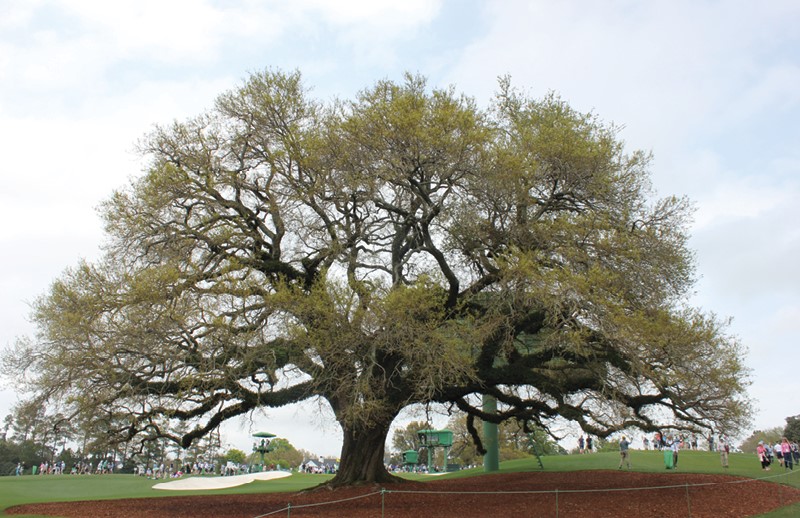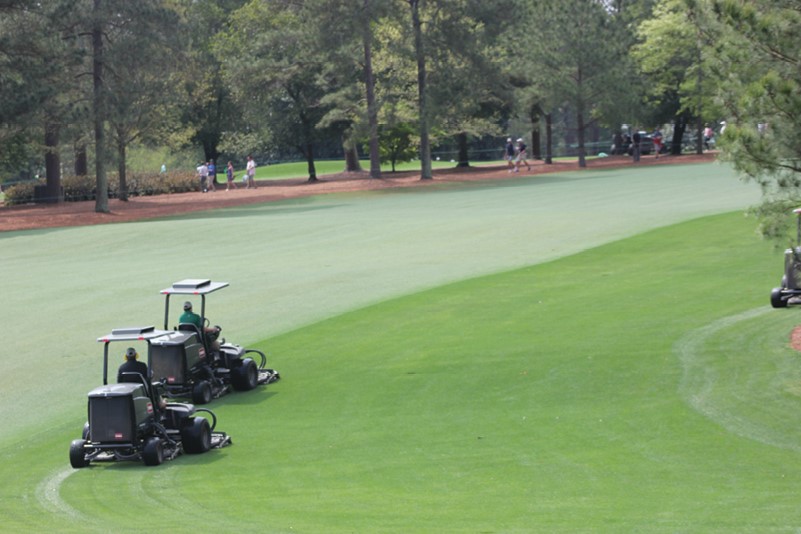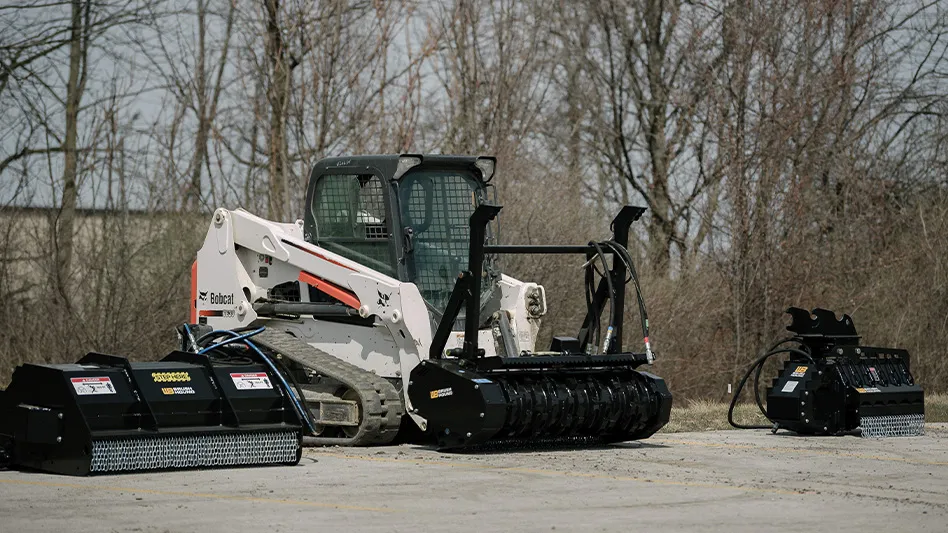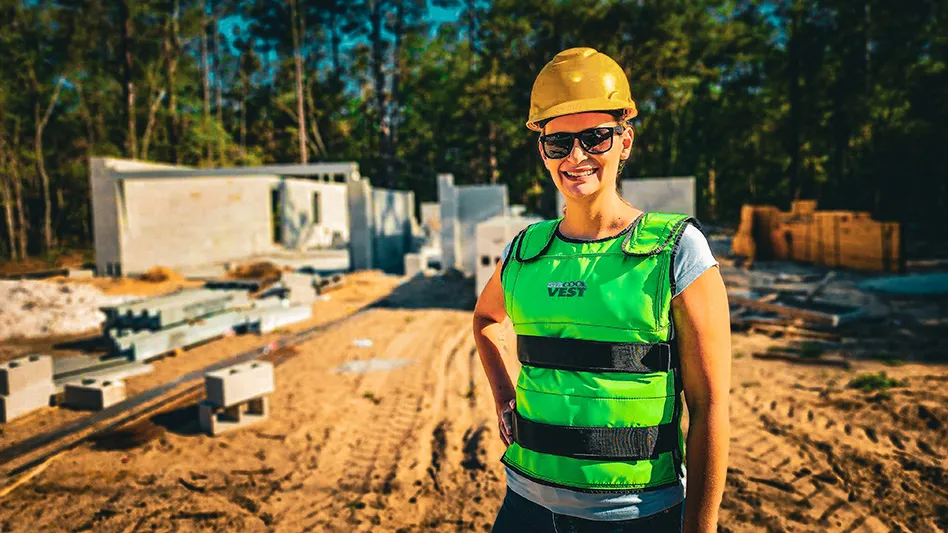
“Hello, friends,” we heard Jim say,
“and welcome to another day
at a course both charming and special:
It’s called Augusta National.”
And so began a splendid morn’
(after so much rain just poured and poured)
when for some reason, would you believe,
they let us walk from tee to green.
Before Tiger grinned and Rory surged —
before Friday’s cut and the field’s purge —
before Scottie simply wowed,
Guy, Lee and I just walked the grounds.
It helps, I think, Masters first-timers
to have a friend a little wiser:
“Go here, watch them, check that, not this,
snap a photo and make a wish.”
Guy helped so much — two trips’ll do that —
and while we gawked, he just hung back.
He did point out some recent change,
but wanted us to seize the day.
And so we did! From nine to noon!
Until we heard the sirens — Boo!
T-storms, tornadoes, fast approaching,
and on our walk they were encroaching.

We dragged our feet as best we could,
walking slowly through the wood.
There was no rush, we tried to wait,
but again were told: “Evacuate.”
No sadder words could’ve been dispensed.
Was our day now in the past tense?
Radio tuned, forecast updated,
inside our car, we sat and waited.
And then — a rush! A flash of patrons
made their way back to the gates, and
could it be? Was that sign accurate?
The course reopened for those with badges!
Back in we walked, smiles unwavering;
this was icing, a bonus, gravy.
The golf gods smiled on tens of thousands,
sent back inside to stroll and browse, and
browse we did, 1 to 18 …
and inside the Golf Shop. See,
I sort of told a bunch of chums
my travel plans: “Please get me stuff?”
The line alone was Disneyesque,
wrapped and curling, a midday rest.
And once inside — gunga galunga! —
whole paychecks died in moments. Oompah!
Six caps, three shirts, a quarter-zip,
a towel trio to clean club drips.
Some playing cards and divot tools,
pin flags, ball markers, all are cool.
My uncle wanted just a ball.
For you, old Tom, an easy call.
Never did see those trendy gnomes —
would’ve sat on my lap the whole way home.
And then some lunch, as light as bricks:
pimento cheese (I ordered six),
four pecan clusters, lemonade,
sweet tea, some bottled waters made,
perhaps, from old Rae’s Creek on 12.
Oh! And one banana, just to help
refuel my legs on grassy stuff —
never enough potassium.
Met up again with Guy and Lee,
there was more course for us to see.
Up and down and up again —
elevation change is real, my friends.
We watched Cam, Vijay and Woosie,
then at the Par-3, Weir and Hughes-y.
The sun peeked through, the day was grand,
and then, oh no, sirens again.
Once more, a voice told us to leave,
and this time, no, no clemency.
We filed out at 4 o’clock,
shoulders touching, golf small talk.
Who knows the next time we’ll return?
Next year, I hope, without concern.
If not, we’ve been there once (or twice),
so we’ve got that goin’ for us, which is nice.

Two good walks
The greenery. The people. The ambition. The golf. Lee Carr’s first visit to the Masters was bliss.
Blooming azaleas. Delicious sandwiches. Busy caddies. Bags of merchandise. As someone visiting for the first time, these are all things I expected to see and enjoy at the Masters. Everyone who had been there told me the elevation changes were going to be more significant than I imagined. They were.
Connected media members. Watchful security. Courteous volunteers. Morning mist. I have never associated cigar smoke with the grounds of Augusta National Golf Club but I occasionally caught that fragrance. I love it because it takes me directly back to my great uncle’s house and the comfortable cadence of my childhood. Truth be told, I felt like a kid. I was at the Masters and, shamefully or not, nothing else really seemed to matter. I don’t think I was alone in this. There was a blanket of joy, a palpable and positive energy across the property. The forecast leading up to Wednesday had been uncertain but my colleagues and I got lucky. We were able to see so much. For me, it was all new and incredible. My cheeks actually hurt at the end of the day from continual smiling.
Flowering Peach. Magnolia. Amen Corner. Holly. Every hole has a lovely name and there are an astounding number of plants on this land, rich in history, that used to be a nursery. So much written about and universally known but secrets remain. Many. There in the open, teeing off on Carolina Cherry, was Viktor Hovland, with a solid strike (I love that sound) before striding down the fairway and smiling, full of athleticism and potential. Hideki Matsuyama, the defending and revered champion, teed off too, as whispers of the previous night’s Champions dinner, with an exquisite menu and exclusive camaraderie, circulated. Not even 100 contenders. Who would win on Sunday?
Babies in white jumpsuits. Giggles. Hugs and family. Courageous putts from loved ones. The Par-3 contest was my favorite part of the day. It was an awesome sight to see the hills covered with patrons for this once-a-year triumph. Members wearing their green jackets watch, beaming like everyone else. On hole No. 5, a group of youthful agronomy workers relaxed and enjoyed the afternoon before they were needed. I couldn’t help but wonder where their careers and lives would take them. I quickly and silently prayed for their health and happiness.
The whirring SubAir. Rolls of sod. A parade of fairway units. Capable grounds crews. We were evacuated once earlier in the day, returned to the grounds and were evacuated again after 4 p.m. as these impressive teams went to work. The course is kept to pristine standards, clearly, and it is its own brand of gorgeous. What stood out to me most was a man driving the edge of the fairway and stopping every few feet to pick up a single pine cone or small pieces of bark no bigger than half a pecan cluster. Total intensity, total dedication. That’s why the results are remarkable. There’s no shortcut and no substitute for ample resources, understanding and hard work. It’s an outstanding achievement.
I had a great time and was grateful for the opportunity. The property is alive. There’s always going to be something new or different, including the much-discussed gnomes, even though the traditions are deeply rooted and it feels like everything has always been where it is. Friends and acquaintances meeting up and firmly shaking hands. Golf conversations everywhere. It’s like wind rustling the trees, alluring and peaceful. I would call on Augusta National again in a heartbeat. It’s classy. Brilliant. Well done.
It’s the Masters.Lee Carr is a Northeast Ohio-based writer and a frequent Golf Course Industry contributor.
Tartan Talks 70

Kevin Atkinson still believes in the power of sketching in golf course architecture, especially when dealing with clients.

“It’s a way to communicate my vision in a realistic way,” he says on the Tartan Talks podcast. “Oftentimes, they’ll use my sketches more than plans to build the vision. They can see it and it’s something they can understand. I think sketching is a critical communication tool to shapers, members and boards. And I do it for me, because it pushes me to be as creative as I can.”
Atkinson has sketches that are more than two decades old inside the garage of his suburban Denver home. That home sits near Red Rocks Country Club, which happens to be one of his clients. Atkinson is also a member of the club and backyard golf architecture conversations with neighbors and fellow members are a common occurrence.
A podcast with Atkinson resembles an affable and thoughtful backyard conversation. His start in the business after he failed to make the University of Nebraska-Lincoln team, incorporating mountain views into designs, and the creativity involved with the modern short-course movement are among the topics he discusses. The podcast can be found on all popular distribution platforms.
“Golf architecture is addictive,” he says. “It’s all I think about and I love it. I’m thankful every day.”
Course news
The LeFleur’s Bluff Education and Tourism Complex in Jackson, Mississippi, announced major plans last month for a new golf facility in the Magnolia State’s capital city that will help to preserve nearly 150 acres of urban green space and create a permanent home for First Tee of Central Mississippi. The project is part of a larger master plan to connect four museums with walking and biking trails and other outdoor recreational amenities. Robert Trent Jones II is collaborating with Mississippi-based architect Nathan Crace on the golf part of the project. … Building on a nearly century-long relationship, the United States Golf Association and Pebble Beach recently announced a long-term partnership. Pebble Beach will now host the 2027, 2032, 2037 and 2044 U.S. Opens, and the 2023, 2035, 2040 and 2048 U.S. Women’s Opens. The resort’s Spyglass Hill Golf Course will host both the U.S. Senior Open and the U.S. Senior Women’s Open, back-to-back, in 2030. … Entrada at Snow Canyon Country Club recently unveiled its new David McLay Kidd-designed golf course to members and dignitaries. During the 17-month renovation project, McLay Kidd redesigned the club’s former Johnny Miller- and Fred Bliss-designed course, which opened for play in 1996. … Tripp Davis and Associates wrapped up their redesign work at Houston’s BraeBurn Country Club. While keeping the same basic routing of the original course, Davis and his team rebuilt and reshaped all the greens, rebuilt and shifted tee locations, and rebuilt bunkers in a more classic style. NorthBridge Bermudagrass was installed along with a new irrigation system and upgraded drainage. … Omni Amelia Island Resort opened Little Sandy, the resort’s unique 10-hole par-3 course, along with an accompanying 18-hole putting course. Created by Beau Welling Design, Little Sandy is designed to appeal to golfers of all skill levels while also offering strategic tests on contoured greens. The design firm is also working on other Omni projects such as Omni PGA Frisco Resort, which is scheduled to open in spring 2023. … The Tom Weiskopf- and Jay Morrish- designed Broken Top Club in Bend, Oregon; the Brian Silva-designed Massachusetts muni Olde Scotland Links; the Club at Sea Palms, designed by George Cobb and situated in St. Simons Island, Georgia; and Oldfield, a private community in Okatie, South Carolina, with a course designed by Greg Norman, all selected Troon for various management needs.

Explore the May 2022 Issue
Check out more from this issue and find you next story to read.
Latest from Golf Course Industry
- Devising safer landings
- SiteOne adds Durentis to product offerings
- Resilia available for purchase in Hawaii
- What can $1 million do for expanding the industry workforce?
- Captivating short course debuts on Captiva Island
- Wonderful Women of Golf 35: Carol Turner
- The Andersons acquires Reed & Perrine Sales
- Excel Leadership Program awards six new graduates





